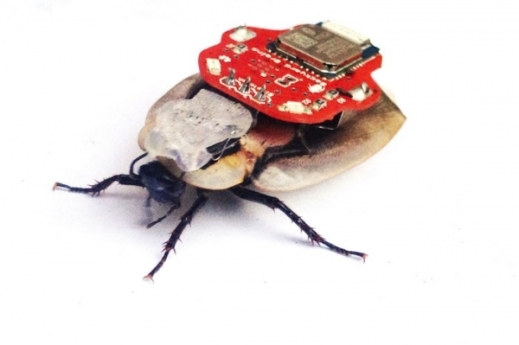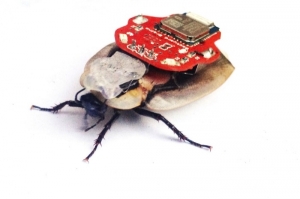Robo Roach

A little company called Backyard Brains sells “the first commercially available cyborg,” or kits that enable you to construct a cockroach remote-controllable by implanting electrodes in its antennae. Human operators can then “drive” these cockroaches, turning them right and left with a smartphone app, for a few hours until the cockroaches become desensitized to the electrodes. The technology attracted critics like the PETA, which argued that the app was encouraging animal torture. Apple and Google both removed Roboroach from their app stores, but the kit is still available online.
The company suggests that the experimental kit is college students and high schoolers with adult supervision.
The RoboRoach is an educational DIY cockroach cyborg kit. It includes one PCB (printed circuit board), a.k.a. “the backpack”, which carries the Bluetooth Low Energy wireless receiver/transmitter (so you can communicate to it via a smartphone), a few indicator LEDs (light-emitting diodes), and other circuit components (resistors and capacitors). A small coin cell battery is also provided to power the PCB’s components. The kit includes 3 sets of electrodes to implant three adult cockroaches.
One end of each electrode set is a connector to plug in the RoboRoach backpack and the other end is a 0.003” silver wire (smaller than the thickness of a human hair) that serves as the conductive electrical element that interfaces with the sensory nerves of the cockroach.
There are 3 electrodes in each set; one for the left antenna, one for the right antenna and one for the ground. Since electricity needs a closed circuit, the ground wire is necessary to provide a return pathway for the electrical stimulation current. The ground can go anywhere in the cockroaches body, but we use the dorsal side of the thorax, near the flight muscles (these cockroaches do not fly), as a ground location of minimal damage to the insect.
cyborg beetle
DARPA is at it again. Actually, they’ve been at it for a while. Since about 2006, DARPA has been working on a system called HiMems: Hybrid Insect Micro-Electro-Mechanical System. This research was debuted right here in Tucson Arizona just this past January 2008 at MEMS Conference! The MEMS system is used to control the locomotion of an beetle by obtaining motion trajectories either from GPS coordinates, or using RF, optical, ultrasonic signals based remote control.
This project happens in three phases. At the first phase, a micro-mechanical system is implemented inside the insect during early metamorphosis which are the caterpillar and the pupae stages of development. The secondary phase involves streaming data back from video cameras, audio microphones and other sensors the insect is carrying. In the future, DARPA hopes to see microfluidic devices that can pack different chemicals to be delivered as payloads or to dispense pheromones to control the flight of swarms. But Darpa’s ultimate plan is to eventually hack into the insects own natural senses, allowing the remote-control operator to look out of the insects own eyes, instead of attaching a video camera for it to carry.
The final phase involves flying the cyborg insect to within five meters of a specific target starting at a distance of one hundred meters. Researchers will use a remote control or automated systems with global GPS to conduct this test. If the research team passes the test successfully, then DARPA can begin breeding multiple beetles.
Three research groups at the University of Michigan, Massachusetts Institute of Technology (MIT) and Boyce Thompson Institute were awarded funding by Darpa earlier in 2007, when the HI-MEMS program began, and all teams are expected to share prelim results during annual reviews. If all teams are successful, then each could be expected to start breeding hundreds of reconnaissance insects.
The University of Michigan is using horned beetles int their program, and MIT and Boyce Thompson are using large moths. At the MEMS conference, all teams had to demonstrate controlled, tethered flight of the insect via their new systems.
To learn more about this project, read the full EE Times article here.



